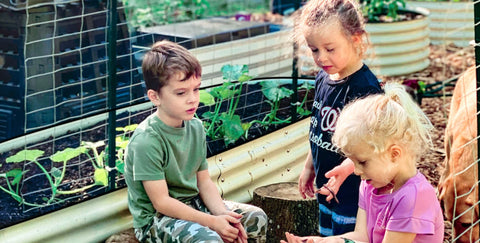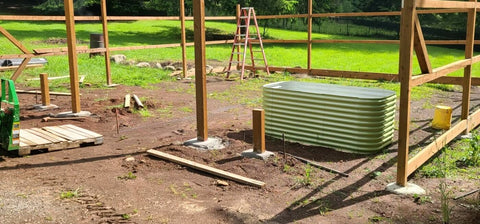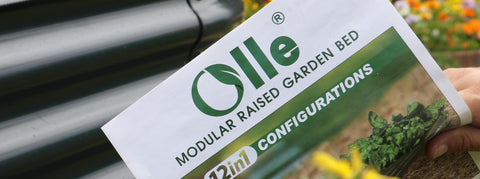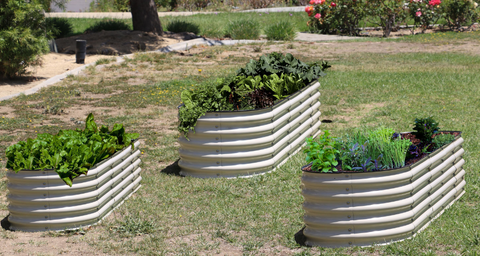What to Plant on The Raised Garden Bed
Learn how to choose from all the cool things you can grow on elevated beds and get some great planting ideas for your own garden.

One of the most exciting things about the elevated bed garden is that you can plant almost anything in it as long as the conditions are right. Imagine the possibilities! However, there are few things you need to consider before choosing a plant. Here are some things to consider, as well as some planting ideas, in case you are looking for some guidance. Oh, don't worry if you don't know some plant names - they are common and easy to find no matter where you buy them.

Sun
The amount of sunlight that hits your elevated bed garden every day plays an important role in determining what kind of plants you can grow. Adequate sunshine (at least 6 hours a day) is the key to the success of most vegetables (such as tomatoes, peppers, pumpkins), many herbs (such as basil, rosemary, lavender) and fruits (think melons, strawberries). Shaded places are most suitable for ornamental plants, such as hairpins, ferns, fritillaria and impatiens. Check the plant label or seed pack for sunlight details.
Sunny Pizza Garden: A sunny place is a great place to grow the ingredients needed to make the pizza night super fresh! Plant tomatoes, onions, peppers, oregano, basil and parsley. If you like the taste of fennel in red sauce, you can also plant fennel and flavor it with seeds.
Water
A raised bed works best when you fill it with plants that need the same amount of water to grow. For example, if you try to pair a thirsty tomato with a dry agave that likes the soil, one of them will be affected. Humid plants that perform well on elevated garden beds include safflower, sedge and aconite. In dry places, try Russian sage, grassland plants (cinchondra, pseudo indigo, big blue stems), Mediterranean herbs (rosemary, lavender) or succulent plants (including sedum and carnation). The plant label or seed package is also your friend here - it should tell you whether your plant is a water lover.

Water saving garden: reduce watering work by using a group of succulent plants, such as golden acre sedum, mattrona sedum, variegated agave and hens. Then add some drought tolerant herbs as spices and colors, such as rosemary, lavender and thyme.
Soil and Food
If you fill your elevated bed with high-quality soil and feed your plants with the right plant food regularly, you can spend time designing your garden without worrying about what you can and cannot grow - because you will be able to grow all kinds of plants from strawberries to eggplants, zinnia to echinacea!
A Bit of Everything Garden: Everyone likes samplers, right? Try to use the same method for your garden to create a pleasant combination of vegetables, herbs and flowers. Plant chilies (chilies are used for heating, and sweet bananas for sweetness), chives, sage, papain squash, dill, and black eyed Susan - or any combination you like personally. Just make sure there is enough space for each plant (check the plant label).

Depth
The soil depth of the elevated bed will also affect your plant selection. Although many plants need at least 12 inches of soil to grow well, other plants, such as lettuce and annual flowers, such as pansy, vanilla and short marigold, can thrive in just 6 inches. Most herbs and vegetables, including tomatoes, peppers and eggplants, are best harvested in soil at least 20 inches deep.
Shallow growth salad garden: For crisp meals directly picked from the garden, mix colorful red and green lettuce, sesame, spinach and Lacinato kale into 6 inches or more of soil. Put a bunch of chives in it, and put a snow pea vine on the grid for a sweet bite. For unexpected cooking effects, plant edible flowers on the edge, such as French marigold and trollius.
Plant Type
In short, perennials are permanent - at least in a few seasons. These plants return by themselves every year. Some perennial plants that grow well on elevated beds include day lily, lavender, oregano, rhubarb, raspberry and hairpin. Just know that if you put them on your bed, they will continue to occupy that space for a long time (unless, of course, you decide to pull them out!).

Mix breakfast all year round: Wake up in fresh berries and flowers, plant dwarf raspberries or blueberry shrubs (very suitable for cereals and waffles), surrounded by cut flowers, and light up your breakfast corner. Consider peonies, echinacea, black eyed Susan and Shasta daisies. On the other hand, annuals are temporary. They only last for one growing season, so you can plant different things in the same space next time. You may want to plant some annual plants in your high bed garden, such as petunias, pansies, basil, lemongrass and tomatoes, potatoes, peppers, pumpkins and onions.

Additional tip: To help reduce the chances of diseases and pests, you don't want to grow annual vegetables in the same place year after year. Come on, let them walk around!
BigonBlooms Annual Garden: Make your bed a colorful destination for people and pollinators by planting annual plants that attract butterflies such as blue and red sage, zinnia, pentas, gomphena and lantana camara.
